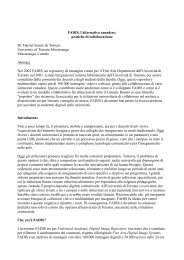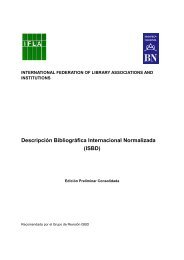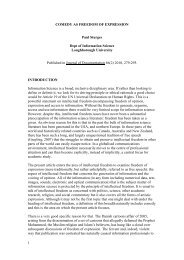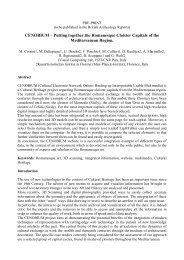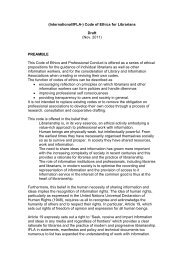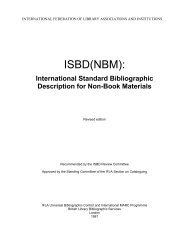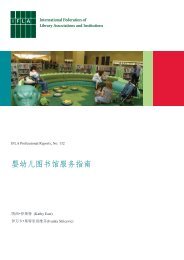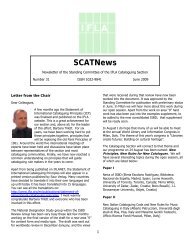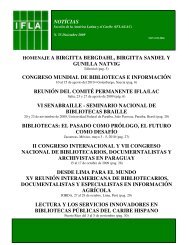English - IFLA
English - IFLA
English - IFLA
Create successful ePaper yourself
Turn your PDF publications into a flip-book with our unique Google optimized e-Paper software.
5<br />
6<br />
Ziraldo<br />
Menino Marrom [Brown Boy]<br />
Melhoramentos, 2001, 28th edition • ISBN 8506010098<br />
In this book (FNLIJ Children Award 1987),<br />
Brazil’s grand artist Ziraldo, author of O menino<br />
maluquinho, a national classical work of children’s<br />
literature, speaks about the relationship between<br />
two children, two friends: the brown boy and the<br />
pink boy. Along the story, both make discoveries<br />
about colors and ethnicity, restating that true<br />
friendship is a value that goes far beyond these<br />
concepts. Also an illustrator himself, the author<br />
has been awarded many prizes and has been<br />
nominated three times for IBBY’s HCA award:<br />
1988, 1990, and 1992.<br />
Winner of the Hans Christian Andersen award<br />
in 2000, Ana Maria Machado tells us the story<br />
of a white rabbit who finds the ribbon girl’s dark<br />
skin a most beautiful thing. He likes it so much<br />
that he tries to find where the color came from<br />
so his offspring can have their hair as black as<br />
a panther’s. This book has been translated into<br />
several languages and is one of the author’s<br />
classical works, because of the many prizes it has<br />
been given: Américas, Best Latin Books in the<br />
USA category in 1997; Colombia’s Fundalectura<br />
Highly Recommendable, and ALIJA, Buenos<br />
Aires’s Best Latin American Children’s Book, both<br />
in 1996; Venezuela’s National Library’s Best of the<br />
Year in 1995; Honorable Mention in the São Paulo<br />
Biennial as One of the Five Best works in the<br />
Biennial. Awarded several FNLIJ prizes for various<br />
books, the author also won the Tokyo Noma<br />
Illustration Contest’s Runner-up award in 2000,<br />
the same year when she was nominated for<br />
IBBY’s HCA award.<br />
the world through picture books • books from brazil • 24<br />
Ziraldo, grande artista brasileiro, autor de O menino<br />
maluquinho, clássico brasileiro da literatura infantil,<br />
neste livro conta a relação entre duas crianças, dois<br />
amigos: o menino marrom e o menino cor-de-rosa.<br />
Ao longo da história, os dois fazem descobertas sobre<br />
cores e etnias, reafirmando que a verdadeira amizade<br />
é um valor que está além desses conceitos. O autor,<br />
que também é ilustrador, já ganhou diversos prêmios<br />
e foi três vezes indicado ao prêmio HCA / IBBY:<br />
em 1988, 1990 e em 1992.<br />
Ana Maria Machado • Claudius, ill.<br />
Menina bonita do laço de fita [Pretty girl with ribbon trap]<br />
Ática, 2001, 7th edition • ISBN 8508066392<br />
Ana Maria Machado, ganhadora do prêmio Hans<br />
Christian Andersen, em 2000, conta aqui a história<br />
de um coelho branco que acha linda a pele escura<br />
de uma menininha que usa laço de fita. Ele gosta<br />
tanto, que tenta descobrir de onde veio essa cor<br />
para ter filhotes pretos como o pêlo de uma pantera.<br />
Este livro foi traduzido em várias línguas e é um dos<br />
clássicos da autora, pois recebeu os prêmios: Américas,<br />
categoria Melhores livros latinos nos EUA, em 1997;<br />
Altamente Recomendável, pela Fundalectura, Bogotá,<br />
Colômbia; e Melhor Livro Infantil Latino-americano,<br />
ALIJA, Buenos Aires, ambos em 1996; Melhores do Ano,<br />
pela Biblioteca Nacional da Venezuela, em 1995; e em<br />
1988, Menção Honrosa – Uma das Cinco Melhores<br />
obras do Biênio, na Bienal de São Paulo. Pela FNLIJ,<br />
recebeu diversos prêmios, desde a década de 70.<br />
7<br />
8<br />
Odilon Moraes<br />
Pedro e lua [Peter and the moon]<br />
Cosac Naify, 2004 • ISBN 8575033387<br />
Little Pedro is a boy who happens to be charmed<br />
by the moon, until he finds out that the pebbles<br />
he finds are fragments from it. Pedro, which<br />
means “pebble”, sympathizes with the pebbles,<br />
as he thinks they might miss home. A turtle<br />
comes across his path and, given the similarity of<br />
its shell with the earth’s satellite, the boy names<br />
her Lua (moon). A strong and beautiful friendship<br />
arises and is firmly established between the two<br />
of them. Lua can no longer stay away from Pedro.<br />
In this book, that speaks of friendship and death,<br />
Odilon Moraes manages to harmonize text and<br />
beautiful black and white images, providing<br />
the work with a delicately poetic tone. In 2005,<br />
the book was awarded FNLIJ’s Children Award.<br />
In 2009, it was included in the White Ravens<br />
catalog of Munich’s International Library.<br />
Ruth Rocha • Carlos Brito, ill.<br />
O que os olhos não vêem [What the eyes don’t see]<br />
Salamandra, 2003, 2th edition • ISBN 8516035697<br />
The people in this kingdom started to suffer after<br />
the king caught a disease that kept him from<br />
seeing and hearing small people. The disease<br />
spread on to the king’s aides in such a way that<br />
the people were no longer seen or heard by them.<br />
After all, the subjects were all so very small… One<br />
day, however, they discover they could be heard<br />
if they spoke all at once in a very loud tone voice.<br />
Based on the popular saying “Eyes that don’t<br />
see, heart that doesn’t feel”, the story challenges<br />
authoritarianism and reflects upon politics, as it<br />
shows what happens when rulers fail to work<br />
with and for the people. Even with these complex<br />
concepts, Carlos Brito’s illustrations manage to<br />
express to readers all of the fun that is necessary<br />
to awaken their imagination. The work is part<br />
of the renowned cycle of kings, around which the<br />
author has another three books that reflect upon<br />
the dominant/dominated issue. In 1982, it was<br />
awarded FNLIJ’s Children Award.<br />
Ruth Rocha was one of the authors who started<br />
the new children and youth literature in Brazil,<br />
in the late 1960’s. She is a most renowned author<br />
in the country. The first edition of this book,<br />
in 1981, was launched in the final moments of<br />
the dictatorship in this country, which officially<br />
extended until 1985. In 2002, she was nominated<br />
by FNLIJ for IBBY’s HCA Award.<br />
the world through picture books • books from brazil • 25<br />
O menino Pedro é encantando pela lua, até que<br />
descobre que as pedras que encontra são fragmentos<br />
lunares. Pedro, que significa “pedra”, sente pena<br />
das pedras, achando que elas devem sentir saudades<br />
de casa. Uma tartaruga atravessa seu caminho<br />
e pela semelhança de seu casco com o satélite,<br />
o menino a chama Lua. Uma amizade forte e bonita<br />
se estabelece entre os dois. Lua não suporta ficar<br />
longe do Pedro. Neste livro que fala da amizade e<br />
da morte, Odilon Moraes consegue harmonizar texto<br />
e belas imagens em preto e branco, proporcionando<br />
à obra um tom delicadamente poético. Em 2005, este<br />
livro ganhou o prêmio FNLIJ Criança. Em 2009, a obra<br />
fez parte do catálogo White Ravens, da Biblioteca<br />
Internacional de Munique.<br />
O povo desse reino começou a sofrer depois que o rei<br />
pegou uma doença a qual o fez parar de ver e ouvir<br />
pessoas pequenas. A doença foi se espalhando aos<br />
demais auxiliares do rei de tal modo que o povo não<br />
era mais visto e nem ouvido por eles. Afinal, os súditos<br />
eram tão pequenos... Um dia, porém, descobrem que<br />
poderiam ser ouvidos se juntos formassem um só<br />
vozeirão. Partindo do ditado popular “O que os olhos<br />
não veem o coração não sente”, a história questiona<br />
o autoritarismo e reflete sobre a política ao mostrar<br />
o que acontece quando os governantes não trabalham<br />
com e para o povo. Mesmo com esses conceitos<br />
complexos, as ilustrações de Carlos Brito conseguem<br />
expressar ao leitor toda a ludicidade necessária para<br />
despertar o imaginário. A obra faz parte do conhecido<br />
ciclo dos reis, no qual a autora tem outras três obras<br />
que refletem sobre a questão dominante / dominado.<br />
Ganhou, em 1982, o prêmio FNLIJ Criança.<br />
Ruth Rocha foi uma das autoras que iniciou a nova<br />
literatura infantil e juvenil no Brasil, no final dos anos<br />
60. É uma das mais conhecidas no país. A primeira<br />
edição do livro, em 1981, foi em meio ao período da<br />
ditadura no Brasil, que durou até 1985. Foi indicada,<br />
em 2002, pela FNLIJ para o prêmio HCA / IBBY.



